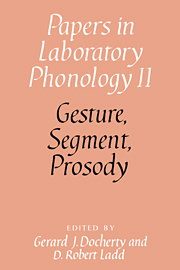Book contents
- Frontmatter
- Contents
- List of contributors
- Acknowledgments
- Introduction
- Section A Gesture
- Section B Segment
- 6 An introduction to feature geometry
- 7 The segment: primitive or derived?
- 8 Modeling assimilation in nonsegmental, rule-free synthesis
- 9 Lexical processing and phonological representation
- 10 The descriptive role of segments: evidence from assimilation
- 11 Psychology and the segment
- 12 Trading relations in the perception of stops and their implications for a phonological theory
- Section C Prosody
- Appendix 1 The test phrases (bold type) of experiment 1 in the context in which they were read
- Appendix 2 The distractors (bold type) of experiment 1 in the context in which they were read
- Appendix 3 The test sentences of experiment 2. The test words are in bold type
- Appendix 4 The distractor sentences of experiment 2. The distractors are in bold type
- References
- Name index
- Subject index
10 - The descriptive role of segments: evidence from assimilation
from Section B - Segment
Published online by Cambridge University Press: 18 December 2009
- Frontmatter
- Contents
- List of contributors
- Acknowledgments
- Introduction
- Section A Gesture
- Section B Segment
- 6 An introduction to feature geometry
- 7 The segment: primitive or derived?
- 8 Modeling assimilation in nonsegmental, rule-free synthesis
- 9 Lexical processing and phonological representation
- 10 The descriptive role of segments: evidence from assimilation
- 11 Psychology and the segment
- 12 Trading relations in the perception of stops and their implications for a phonological theory
- Section C Prosody
- Appendix 1 The test phrases (bold type) of experiment 1 in the context in which they were read
- Appendix 2 The distractors (bold type) of experiment 1 in the context in which they were read
- Appendix 3 The test sentences of experiment 2. The test words are in bold type
- Appendix 4 The distractor sentences of experiment 2. The distractors are in bold type
- References
- Name index
- Subject index
Summary
Introduction
Millennia of alphabetic writing can leave little doubt as to the utility of phoneme-sized segments in linguistic description. Western thought is so dominated by this so successful way of representing language visually that the linguistic sciences have tended to incorporate the phoneme-sized segment (henceforth “segment”) axiomatically. But, as participants in a laboratory-phonology conference will be the last to need reminding, the descriptive domain of the segment is limited.
All work examining the detail of speech performance has worried about the relation between the discreteness of a segmental representation, on the one hand, and, on the other, the physical speech event, which is more nearly continuous and where such discrete events as can be discerned may correspond poorly with segments. One response has been to seek principles governing a process of translation between a presumed symbolic, segmental representation as input to the speech-production mechanism, and the overlapping or blended activities observable in the speech event.
In phonology, too, the recognition of patternings which involve domains other than the segment, and the apparent potential for a phonetic component to behave autonomously from the segment(s) over which it stretches, have been part of the motivation for sporadic attempts to free phonological description from a purely segmental cast. Harris (1944), and Firth (1948), may be seen as forerunners to the current very extensive exploration of the effects of loosening the segmental constraints on phonological description under the general heading of autosegmental phonology.
- Type
- Chapter
- Information
- Gesture, Segment, Prosody , pp. 261 - 289Publisher: Cambridge University PressPrint publication year: 1992
- 38
- Cited by



